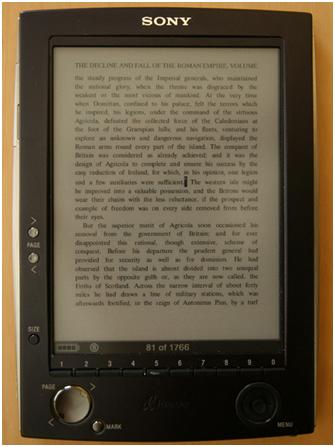The Sony PRS-500 reader is a breakthrough device for the use of electronic documents. It is the first device of any kind that makes it unnecessary to print out documents to make them readable or portable. The Sony reader’s E-Ink display is not equal to paper, but it’s close enough for general use – unlike any CRT or LCD display in existence.

There are a lot of problems with the PRS-500.
It can be intolerably slow, especially when opening documents or entering menu commands.
There’s a horrendous blink when you turn a page. It goes totally black, then back to normal with the new text.
It was obviously designed by Japanese engineers who read books backward from the way Westerners do. There are two page-turning buttons on the left side of the device, where a Japanese reader would instinctively reach to turn the page of a book or magazine. There are none on the right, where I want to reach.
There is no hierarchy or other way to organize books and other files. If you use an SD card or memory stick you can use directories to store your files, but the PRS-500 displays them all in alphabetical order.
There is no way to search files or search within files.
In theory, it handles Word document files, Windows .rtf files, and Adobe PDF files in addition to Sony’s proprietary BBeB format and text. In practice, anything except text or BBeB is probably unreadable. Even at the maximum magnification, most PDF files display with spindly, grainy fonts I need to squint to read. Word documents with tables, graphics, or other formatting features become incomprehensible messes on the Sony reader’s screen.
Depending on the file type, there are only two or three different font sizes.
Word document files are listed according to their metadata title, not the document filename. This is all too often meaningless.
The joystick / menu wheel has limited functionality – for example, you can’t use it to turn pages.
Most damning, the proprietary, DRM’d file format means that any investment in books for the Sony reader is doomed to be a relative waste.
Its display is not the equal of paper. Its contrast is lower than white paper, more like black type on grey or strongly off-white paper.
For all that, it is the first new device in years that has significantly improved my life. What’s so good about it?
Mostly, the display. The default font is sharp and readable. The E-ink display depends on incident light for illumination, and that is its key advantage. It eliminates the eyestrain and fatigue that backlighting produces. It is good enough to read for hours at a time.
Battery life is certainly adequate. Sony rates the unit for 7000 page turns. I have not achieved that, but I have not run the unit down to failure either. I can easily get in two weeks of moderate reading (3 or 4 books) before recharging.
Text-file handling is good. Text files are listed according to their filename without extension. Text wrapping honors linefeeds, which can be a problem with some older e-texts that are formatted with long lines and linefeeds – the result is short orphan lines in the display. I have written a short Perl script that helps with some texts.
Some lonely engineer or product manager at Sony managed to battle the corporate droids and add the feature of supporting SD cards as well as Sony’s proprietary Memory Stick. Whoever it was deserves a gold medal, because supporting cheap and ubiquitous SD memory is a major advantage.
The Sony reader makes it possible to use Gutenberg.org e-texts as real substitutes for the paper books.
Here are my suggestions to improve it:
- Put page turning controls on the right, where Western readers expect them. This would make the reading experience more like handling a real book.
- Accept HTML – even a limited subset. HTML is designed for constrained devices and most sophisticated behavior is optional. Many e-texts are available in HTML format. It’s easy enough (for me) to convert them into text, but it would be far better if the reader could try to approximate the formatting without giving up on readability.
- Recognize and display folders / directories. This would let me organize my reading – “Fiction”, “Classics”, “Light Reading”, etc.
- Get rid of PDF and Word document support. If they can’t be made readable, don’t waste my time.
- In addition to selling e-books at a discount to paper books, why not just include the e-book for free if I buy a paper copy? Collect the Amazon affiliate fee and you don’t need to bother with logistics; since I’m not paying extra for the e-book I won’t mind Sony’s brain-dead copy protection nearly as much.
That’s it! Any other significant improvements would take increases in processing power, improvements in the E-ink technology, or vastly more complex software to implement. But is Sony did these five things, I predict the Sony reader could become as ubiquitous among serious readers as the iPod is among heavy music listeners.












